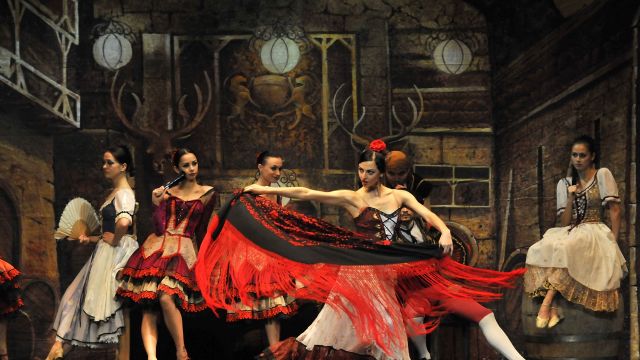A Festival of Russian Ballet
Australian audiences have had a love affair with Russian dance companies ever since Michael Edgley and Andrew Guild began touring them to Australia in the 1960’s. It’s this love of Russian dance that permeates the whole performance of the Festival of Imperial Russian Ballet, a pop-pourri of popular pieces from the classical repertoire.
The company, formed by ex-Bolshoi principal dancer Gediminas Taranda in 1994, are in the middle of a three-month tour of Australia and New Zealand which sees them playing not only capital cities but also regional dates, something they’re done successfully for the last decade. By building an audience, particularly in regional Australia, they have filled a niche that the Australian Ballet and state sponsored ballet companies rarely fill.
They know their audience which the program reflects. The first act featured a cut-down-to-one-act version of the four-act Don Quixote, a ballet they had previously danced in full in their 2011 tour. The character of Don Quixote was reduced to a mere walk-on with little narrative of his lofty and chivalrous ideals, but it did retain the flashy cape-swirling toreador dance and the final grand pas de deux beautifully executed by Lina Seveliova as Kitri and Sergey Kheylik as Basilio.
 Taranda’s choreography was impressively realised in Act-Two’s Bolero, set to Ravel’s pulse-building music. With the entire company dressed in black leotards with billowy gold-lined skirts, it was the most modern of the pieces presented and the most effective. Anna Pashkova was a dynamic Godhead.
Taranda’s choreography was impressively realised in Act-Two’s Bolero, set to Ravel’s pulse-building music. With the entire company dressed in black leotards with billowy gold-lined skirts, it was the most modern of the pieces presented and the most effective. Anna Pashkova was a dynamic Godhead.
Act-Three’s divertissements were basically a Greatest Hits collection with pas de deux’s from Le Corsaire and Giselle, the Dying Swan and the Russian Dance from Swan Lake. The opening Dance of the Horses, a paean to Australia’s obsession with the Melbourne Cup, was jaunty and spirited, and danced perfectly to Rossini’s William Tell Overture, Shostakovich’s music was a good fit for the Russian Waltz which had the ensemble as participants at a high society ball in black tie and tails, but it was Denys Simon’s Cossack solo in Gopak (Taras Bulba) with his spectacular spins and leaps that raised cheers and bravos from the audience. He was magnificent.
The finale of the Can Can Surprize was given an extra jolt of joire de vive by Vladimir Dorofeev, whose performance as the Dame was big on mugging and high en-pointe. The audience clapped so enthusiastically that the company repeated the finale to even more thunderous cheers.
This was popular classical dance from a company whose work was never less than energetic and frequently gob-smackingly thrilling!
Peter Pinne
Subscribe to our E-Newsletter, buy our latest print edition or find a Performing Arts book at Book Nook.

